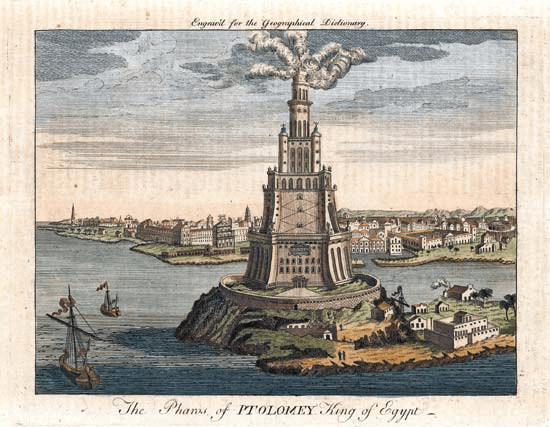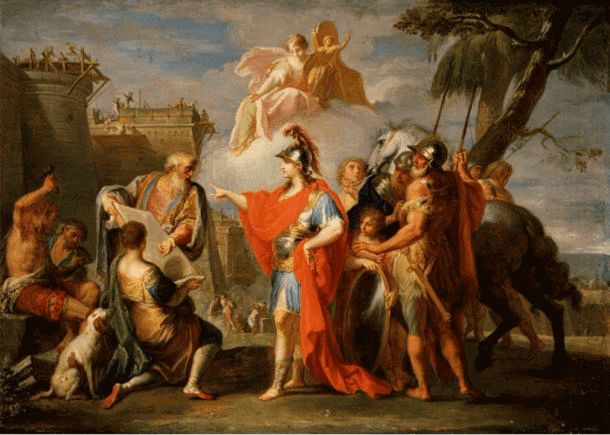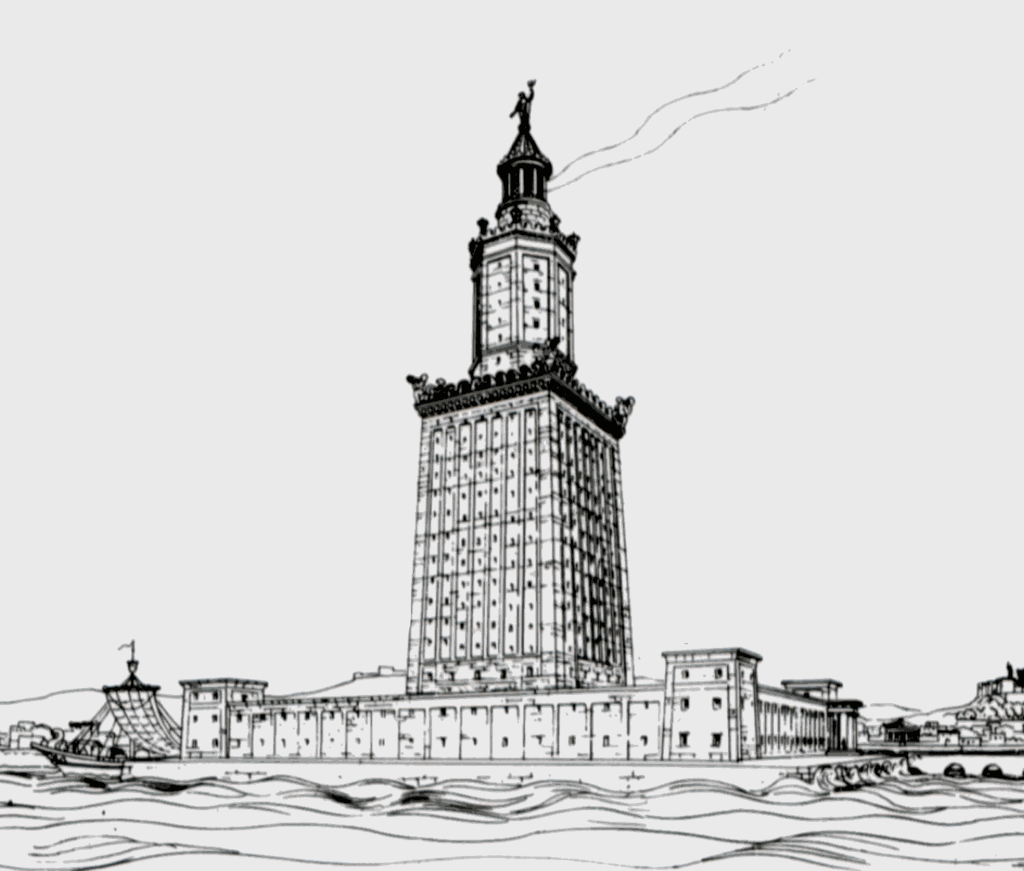Hellenistic Structures > Pharos Lighthouse at Alexandria
Pharos Lighthouse at Alexandria

Background
The Pharos Lighthouse was a massive lighthouse that was constructed on Pharos Island off the coast of Alexandria in the Ptolemaic Kingdom of Egypt. It was part of Alexander III the Great's plan to build Alexandria into a massive multi-cultural Hellenistic port city that was later fulfilled by the Ptolemaic Kingdom. It is classified as one of the Seven Wonders of the Ancient World.

Pharos Lighthouse - Fischer von Erlach
Origins
The origins of the Pharos Lighthouse are tied in myth and legend themselves. According to Alexander the idea for the lighthouse came after he visited the oracles at the Siwa Oasis. Upon visiting the Temple of Amun at Siwa, he was created by the priests there. Alexander was viewed as a liberator from the ineffective Persian rulers and was able to basically walk through Egypt unimpeded. He was greatly respected and welcome among the Egyptians and was welcomed as a son of Amun. At Siwa it came to him in a divine vision that he should create a grand city on he coast of Egypt at the island of Pharos. According to him, an old man in this dream came to him and said:
"Now there is an island in the much-dashing sea, in front of Egypt; Pharos is what men call it."
This transformation can be seen even on the coins of Alexander's empire. He is depicted with horns much like the god Amun has when he is in his form. This connects Alexander with his divine father and was all part of Alexanders personal philosophy. It would be here at the island of Pharos that his great planned city would eventually materialize. Building on top of the pre-existing settlement of Rhacotis, the city of Alexandria would eventually grow to become one of the largest and most prominent in all of Egypt.

Alexander the Great Founding Alexandria - Placido Costanzi (1702-1759 CE)
Construction
In the time of Alexander the island of Pharos was just that, an island. It was even described by the fabled Greek poet named Homer back during Mycenaean times. It was said to be the home of Proteus who was the old man of the sea that lived on the island. According to Od.4/354-357 Homer is quoted as saying:
"There is an island there in the heavy wash of the open sea, in front of Egypt and they call it Pharos, as far as the distance a hollow ship can make in a whole day's sailing when a sharp and following wind is blowing onward."
Alexander was only to stay six months in Egypt in 332 BCE and did not live to see the construction of the Pharos Lighthouse or the Library of Alexandria or the growth of the city itself. He helped plan the city and left the construction of Alexandria and its associated structures to his trusted engineer named Dinocrates. The city itself was laid out in a grid system with a major road going through the city.

Pharos Lighthouse - Maerten Heemskerck (1572)
According to Strabo in his work Geography, the reason for the construction of the Pharos Lighthouse was that the seas were rough around the city and therefore there needed to be some way to guide the ships into the strategic harbors that were created. Control over the lighthouse is extremely important in controlling the city of Alexandria and even Julius Caesar noted this when he attempted to invade the city to back up Cleopatra VII during the Alexandria civil war.
The construction was believed to have been sponsored by a wealthy Greek named Sostratus of Cnidus and construction began at the same time as the city of Alexandria itself. The lighthouse would not be finished until the rule of Ptolemy II Philadelphus in the later Hellenistic Ptolemaic Kingdom. The lighthouse was estimated by Pliny the Elder to have cost about 800 talents. Considering each talent is worth 928 ounces of silver this is equivalent to 742,400 ounces of silver. At a rate of about $16.00 per ounce in modern day currency, this equates to about $12 million dollars. This was a tremendous amount of money in the ancient world.
Causeway
First Dinocrates needed to construct a bridge or causeway that would reach out and connect Pharos Island to the mainland.
The lighthouse itself was believed to have been about 120 m tall (393-450 ft), which is roughly the height of the Great Pyramid of Giza (139 m / 455 ft). This was a truly massive structure if you consider it in these terms as the Great Pyramid dwarfs any modern structure in Cairo today. Some of the ancient historians such as Epiphanes described the height of the Pharos Lighthouse at 306 fathoms of 1,836 feet so this was clearly an exaggeration. By comparison as well, the tallest stone lighthouse is the Ile Vierge in France that was built in 1902 and is 82.5 m (271 ft) tall.
Design
Not much is known about the original design but according to Strabo in his Geography he says the lighthouse was constructed out of white marble and is many stories tall.
The best description of the Pharos Lighthouse comes from the Arabic traveler named Abou-Haggag Al-Andaloussi who visited Alexandria in 1166 CE. He describes the the structure was composed in three stages, the first being a low square about 183.4 feet tall with a cylindrical core. The middle section of the lighthouse was octagonal and each side had a length of 60 feet and a height of 90.1 feet. The third section was circular and had a height of 24 feet.
He also describes walking around the island itself and wandering through the lighthouse itself. According to him there is a very high door and an inscription he cannot read. In his era, he describes how a mosque was built on the top of the structure. This has led researchers to believe the lighthouse was serving alternative functions in this era.
Lighting
What was used to cause the great light of the Pharos Lighthouse? According to ancient accounts it was a massive fire that was reflected by massive mirrors on top of the lighthouse. The constant burning fire would have demanded a huge amount of resources and leads researchers to wonder what type of fuel was used. The use of mirrors would decrease the size of the fire required, and is theorized by some to be the manner of construction of the functional part of the lighthouse.
There are no examples of large bronze mirrors that were used in the Pharos Lighthouse except for an account from a Chinese traveler named Zhao-Ru-gua called Zhu Fan Zhi in 1,225 CE. This account describes how four horses could ascend the ramp going to the top of the lighthouse and it could also be garrisoned by a huge number of men to protect it if necessary. In fact, according to this Chinese text the defense of the lighthouse was a high priority for their national security and would station up to 20,000 men at a time to defend it. The text also describes a massive bronze mirror at the summit that could also be used to detect incoming enemy ships or possibly even burn them using the Archimedes Death Ray principles.
This would give the defending soldiers a chance to garrison the lighthouse and prepare for an invasion of the city. However, according to this ancient Chinese texts a foreigner came to Alexandria and took up a menial position in the guardhouse below the lighthouse tower. For years he worked beneath the radar but one day when the opportunity arose he stole the mirror and threw it into the sea before fleeing Egypt.
The distance the light could be seen also various by ancient accounts as well. According to Josephus in his Jewish War, the light could be seen from 34.5 miles away, yet according to Lucian Samosata it could be seen from about 300 miles away. So what can contemporary lighthouses reach? Well some can reach up to 24 nautical miles or 37 km away in clear conditions and the Pharos Lighthouse was taller than any known stone lighthouse in use today.
Roman Empire
Caesar seized lighthouse due to strategic positon.
Destruction
The Pharos Lighthouse was most likely destroyed by a series of earthquakes that also saw the destruction of Cleopatras Palace at Alexandria. The Pharos Lighthouse was described as intact by Zhao-Ru-gua in 1,225 BCe but by 1,326 CE the traveler Ibn-Battuta described the lighthouse as being partly in ruin, probably due to the first rounds of earthquakes. By the time he returned to the city of Alexandria in 1,349 CE he described the lighthouse as:
"In so ruinous a condition that it was not possible to enter it or climb it up to the doorway"
So where did it go? Well it is believed that the Pharos Lighthouse probably is sitting on the bottom of the Mediterranean Sea right now. Between 320 and 1303 CE there had been 22 earthquakes documented by Arabic writers. According to the accounts the upper-story of the lighthouse was lost in 796 CE. Cracks started to appear in the second-story structure between 950 and 956 CE and about 22 m of the tower collapsed.
In 1,261 CE another earthquake occurred which did more damage to the lighthouse. Noting the horrible state of disrepair, the sultan Salah el Din ordered its restoration. However, another earthquake on August 8th, 1,303 CE known as the Crete Earthquake would badly affect Alexandria. According to the Arabic historian ibn Taghribardi, the lighthouse was badly damaged during this time. As discussed the final destruction of the lighthouse occurred in between the voyages of Ibn Battuta who visited the city twice in a span of twenty years and documented its final ruins.
The lighthouse most likely slipped into the sea shortly after. The site of the Pharos Lighthouse was later occupied by the Citadel of Qaitbay which is an Islamic fort that was built by the sultan Al-Ashraf Sayf al-Din Qa'it Bay in 1,477 AD during the Crusades. It is positioned on the eastern side of the northern tip of Pharos Island at the mouth of the Eastern Harbor, right where the lighthouse itself was believed to have been constructed. Some believe that the Citadel is either constructed with some of the stones of the great lighthouse or on top of the foundation stones.
Reconstruction
A modern reconstruction of the tower was attempted in 1908 and 1909 by the German researcher Hermann Thiersch. He examined coins, mosaics and terra-cotta artifacts in order to discern the true shape and design of the Pharos Lighthouse. His reconstruction has remained the most popular view of the lighthouse in the modern era and can be seen below.

Alexandria Lighthouse - Hermann Thiersch (1908)
Modern Excavations
A French team believes they have found part of the Pharos Lighthouse off the coast of Alexandria and have brought up magnificent statues from the bottom of the Mediterranean that corroborate the idea that the Pharos Lighthouse was destroyed over time by successive earthquakes. While no blocks have been brought up, they are clearly documented underwater.
Pharos Lighthouse Mosaic - Libya 4th Century CE
Pharos Lighthouse Engraving - Magdalena de Passe (1614)
Pharos Lighthouse Painting - Hermann Thiersch (1909)
Pharos Lighthouse - 1872
Pharos Lighthouse - Geographical Dictionary, London (1756)
Modern Day
Today, many modern buildings draw inspiration from this iconic view of the Pharos Lighthouse. One is the George Washington Masonic National Memorial that is located in Alexandria, Virginia. A replica of the Lighthouse of Alexandria is also found in modern day China in Changsha as well as inspiring the Sheraton Hotel in Batumi, Georgia. It is also featured in the Terra Mitica theme park in Spain.
Sources
Julius Caesar, Civil Wars - History Archive
Strabo, Geography - History Archive
- Acra
- Alexandria Structures
- Antigonid Structures
- Antioch Structures
- Arcadian Gate At Messene
- Bam Citadel
- Belevi Mausoleum
- Caesareum Of Alexandria
- Canopic Way
- Cleopatras Palace At Alexandria
- Colossus Of Rhodes
- Craterus Ex Voto
- Delos Synagogue
- Dura Europos Church
- Edicts Of Ashoka
- Esaggila
- Etemenanki
- Ex Voto Of The Attalids
- Filippeios Krini
- Fortifications Of Demetrias
- Fortifications Of Derbent
- Fortress Of Acrocorinth
- Gates Of Alexander
- Great Library Of Antioch Destruction
- Great Library Of Antioch
- Great Pyramid Of Giza
- Gyaur Gala Fortress
- Hanging Gardens Of Babylon
- Heliodorus Pillar
- Hellenistic Arches
- Hellenistic Architecture
- Hellenistic Columns
- Hellenistic Hydraulic Structures
- Hellenistic Libraries
- Hellenistic Monuments
- Hellenistic Ornaments
- Hellenistic Temples
- Ishtar Gate
- Kapilikaya Rock Tomb
- Library Of Alexandria Destruction
- Library Of Alexandria
- Library Of Pergamon Destruction
- Library Of Pergamon
- Machicolations
- Mausoleum At Halicarnassus
- Monument Of Prusias II
- Monumental Gateway Of Antioch
- Necropolis Of Alexandria
- Oracle At Delphi
- Pergamon Altar
- Pergamon Structures
- Persian Royal Road
- Pharos Lighthouse At Alexandria
- Philippeioi
- Philippeion
- Ploutonion At Hierapolis
- Poliorcetics
- Priene Inscription
- Ptolemaic Baris
- Ptolemaic Structures
- Pyramid Of Hermel
- Royal Palace Of Antioch
- Royal Tombs At Vergina
- Sanctuary Of The Great Gods
- Sebasteion Of Aphrodisias
- Seleucid Structures
- Serapeum
- Seven Wonders Of The Ancient World
- Statue Of Zeus At Olympia
- Temple Of Apollo At Daphne
- Temple Of Apollo At Didyma
- Temple Of Artemis At Ephesus
- Temple Of Artemis At Sardis
- Temple Of Athena Polias At Priene
- Temple Of Dendera
- Temple Of Edfu
- Temple Of Kom Ombo
- Temple Of Melqart
- Temple Of The Nymphs
- Temple Of Zeus At Olympia
- Temple Of Zeus At Seleucia Pieria
- Theater Of Dion
- Theater Of Epidaurus
- Tomb Of Alexander The Great
- Tomb Of Cyrus The Great
- Tomb Of Juba II
- Tomb Of Midas
- Tomb Of Philip II
- Tombs Of The Kings Of Pontus
- Tumulus Of Kasta Hill
- Walls Of Alexander
- Walls Of Babylon
- Walls Of Messene